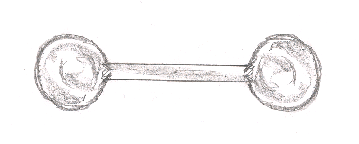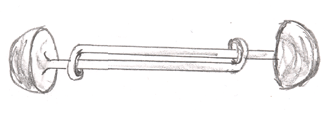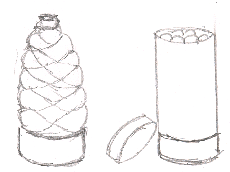In both case, it was a round designed to expand in some fashion upon leaving the barrel. Typically it was two cannon balls or two halves of a shot attached together either by iron bars or chains. When fired they would fly through the air in a some what erratic behavior. However when they hit something solid they caused major damage, wrapping around masts and reducing them to splinters or breaking through a deck only for one of the balls to get snagged thus forcing the other ball to violently rip back through in the opposite direction, or taking out whole sails by simply ripping them to shreds. Here are some basic designs.
Bar Shot
Basically to cannon balls attached together by a solid bar.

Expanding Bar Shot
Two shot halves attached together by bars that slide apart, thus increasing their length and causing even more dire consequences on impact.

Jointed Bar Shot
Again two shot halves attached by bars, in this case, the shot halves fold together and come apart once fired.

Chain Shot
Two shot halves attached together by chains. note the halves are notched so as to be fitted together when loaded.

Bundle Shot
This was similar to the Bar shot but especially designed for personnel. Several short iron bars would be bundled together with a length of rope. The bundles would be custom made to fit snugly down the bore of a cannon. Once fired, the rope would loosen and the iron bars would begin to spread apart. Once these bars hit anything they would begin tumbling, wreaking havoc to bone and flesh and wood, and sail.
Canister, Case and Grape Shot
Canister is similar to a bundle shot but in this case a large cask or metal container would be filled with small iron balls or stone. Grape shot is similar to canister. Iron balls approximately one inch in diameter. were packed in bags and loaded down the barrels between wooden discs. Case or canister round would release their deadly rain of steel on impact. Grape shot released it's hell at the bore of the gun. Very effective at close range. It was often used to repel boarders.

To the left in the image is grape shot. So named because of its resemblance to a bundle of grapes wrapped in cloth. Not the block of wood on the bottom of the round.
To the right is a cnnister round with the lid open. Even the cannister round has a large disc of wood on the bottom.
Sangrenel
This was probably the most deadly or feared of the anti-personnel rounds. Simply put, it was a cloth bag of jagged scrap iron. The bag disintegrated when the powder ignited and jagged bit of iron flew in all directions. The wounds it produced were hideous and there was little possibility of removing the jagged iron from a body without causing grave danger, even if it were partially exposed.

The only author and editor of all pages on the site. Most of what I write about is based on years of book reading on the topic. My first web page was published back in 1994.